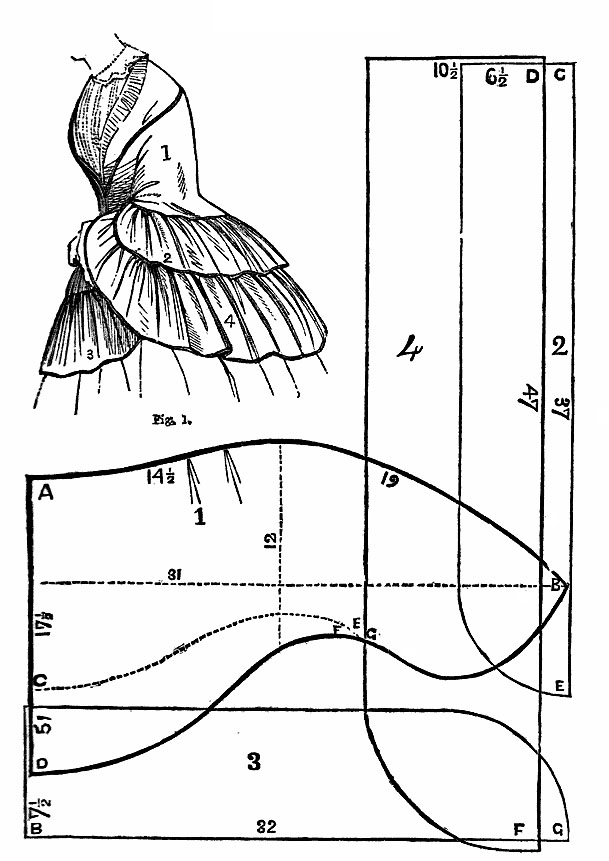In Peterson’s magazine of 1855 I found this article on how to make your own Echarpe Orientale- which was a fashionable article of clothing worn in the 1850s.
The Echarpe Orientale is all the rage in Paris. Its is modeled so as to rest on the shoulder in a graceful curve in the very spot that gives a classic outline to the bust, as may be seen by the accompanying figure. To keep the scarf in the position here give, two pins must attach it to the dress just above figure No. 1, in front of the shoulder; a couple of moderately wide ribbon strings fasten it at the waist, more or less shut according to the form of the wearer; and a brooch to keep this knot steadily fixed is advisable. Much depends on wearing a dress properly, without which precaution the best shaped article will fall the wrong way.
The Echarpe Orientale seems likely to remain long a favorite in the gay city of Paris, and to supersede all others, for the simple reason that, without being remarkable, or outre in appearance, it shows off the figure to the best possible advantage. Any young lady can understand, by referring to an inch measure, how to cut it. The artist having numbered the inches exactly, all that is requisite is to have a long tape with inches marked on it, to refer to when cutting out.
To make an Echarpe Orientate according to the pattern given, (being that suited to a lady of ordinary size) four yards of black glace silk, three quarters of a yard wide, is necessary; but should the height of the person, and width of the bust and shoulders be greater, more will be required, as the first frill and trimming must begin from the waist, and that in front must end within a quarter of a yard of the knee.
Having cut the pattern in paper, or old linen, according to the measurement given, it will be well to try it on the figure, and remark whether any alteration is necessary. The principal matter to be observed is, that the slight gatherings indicated on the body of the echarpe, just above the figure No. 1, should be gathered gradually to fit nicely round the front part of the shoulder, becoming plain again at the curved part, which is rounded so as to rest on the bust.
This done, the frills should have hems folded back of about one inch in width, and black velvet ribbon of the same breadth placed above them. No. 2 should then be quilled in flat plaits of two inches wide, having one inch of space between each plait, and fastened down on the line marked C E, the letters on the frill being placed exactly on those corresponding on the echarpe. No. 4 must be plaited, and placed in exactly the same manner, only it must pass beyond No. 2 (at the turn of the arm) so as to let the hem and trimming be seen beyond. No. 8 crosses under, reaching to E, which finishes the mantle nicely, and allows a free passage for the arm at the part alluded to. This frill has three plaits the same width as the others at the bottom of the mantle, and one at the corner; but the rest, as far as the letter F, is plain. This done, a similar band of ribbon velvet should be placed all round at the edge of the echarpe, so as to finish it neatly, that above the frills resting upon the first.
As the black glace silk used for those echarpes ought to be good, no lining is required; but as our climate is much more variable than that of France, it is well to provide against it. Thus, in winter, a lining can be added; only be sure it is cut out aud tacked on so as to fit the echarpe exactly, and, as the chest is uncovered, a thick, high jacket (or basquine) should be worn with it, or at least a piece of wadding or flannel over the chest.
For summer spotted white muslin made up in this way is very light and pretty, and can be made to look more dressy if wanted for a fete or promenade, by having plain rose-colored, blue, light green, or lilac ribbon inserted the hems, where they are indicated in the figure given.
Others may be made of plain muslin, with hems of the same. Others of the same material with worked frills, or with light embroidered sprigs on the scarf, and frills of a pattern to match.

